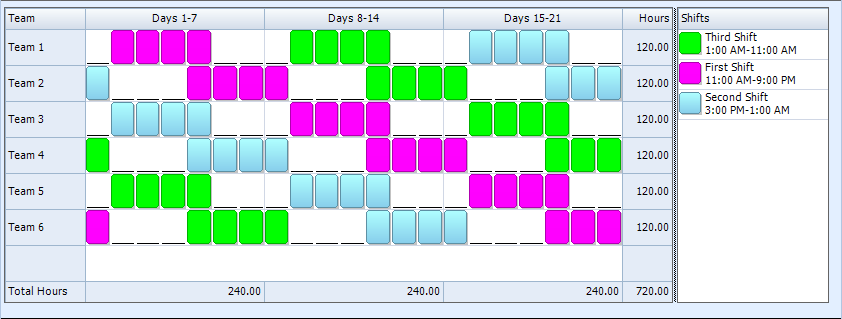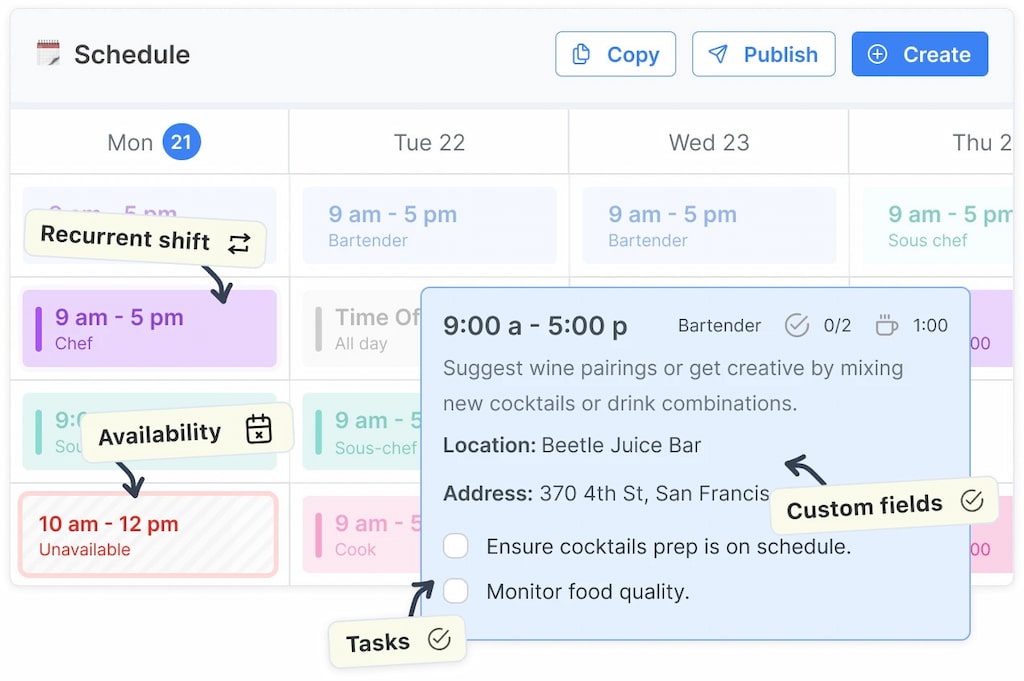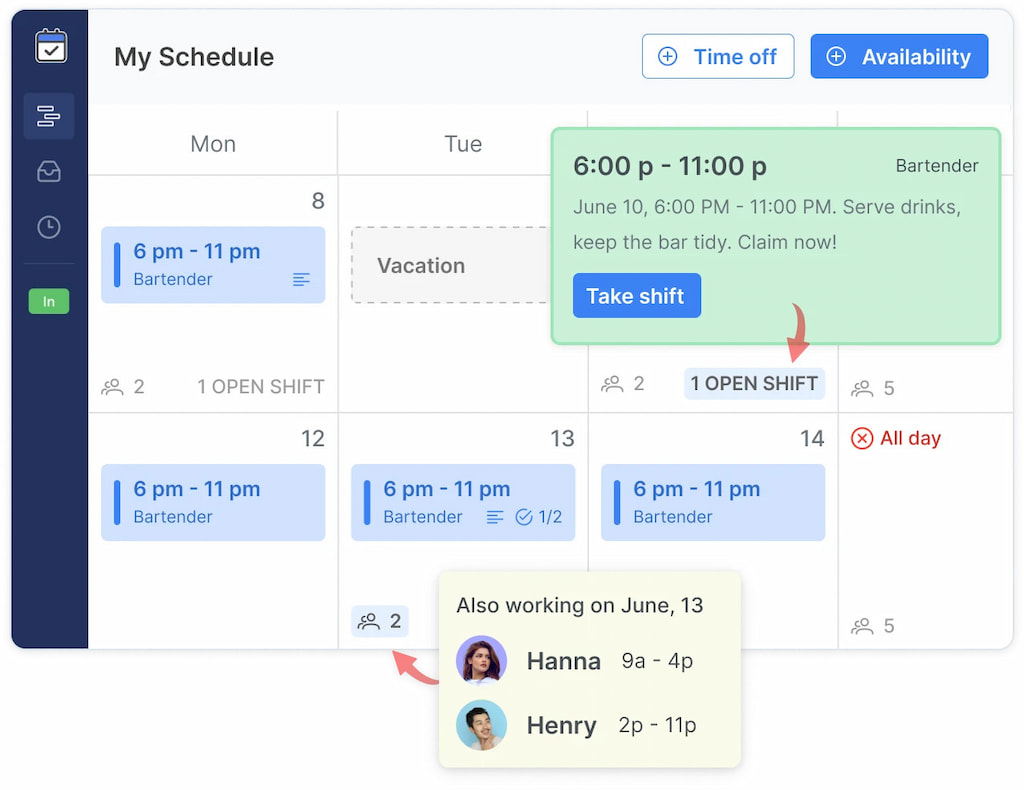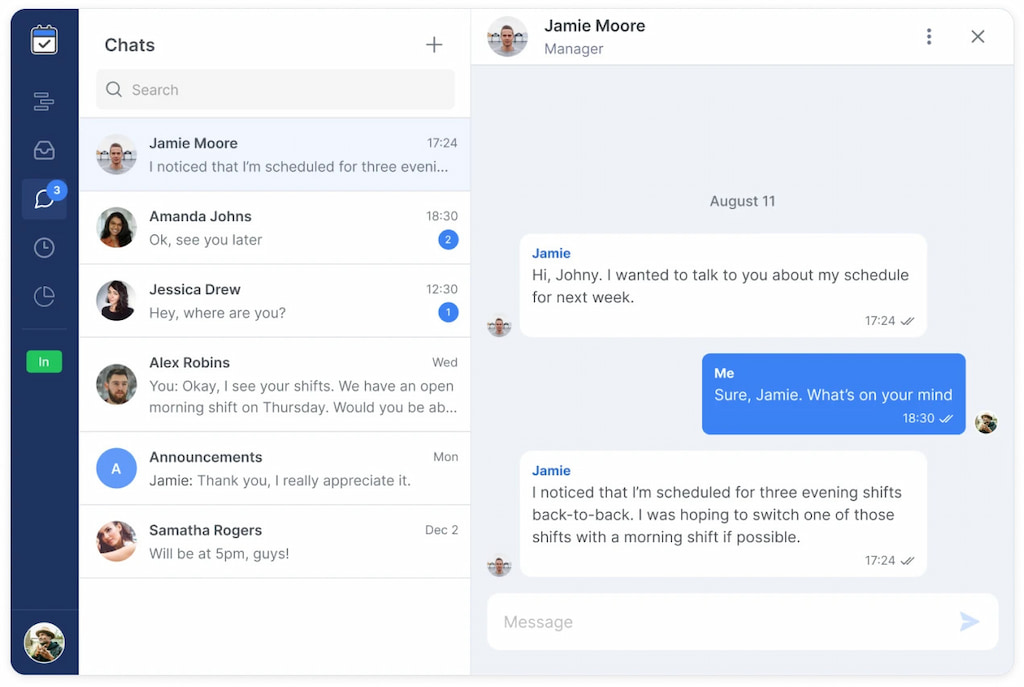What Is a Flex Shift in a Hospital? A Complete Guide to Flexible Nursing Hours

Flexible scheduling isn’t just a buzzword – it’s a lifeline for hospitals facing staffing shortages and burned‑out nurses. In this guide, we’ll unpack what is a flex shift in a hospital, explore common nurse scheduling models, and explain why giving clinicians control over their hours can improve care and retention. You’ll also learn how smart medical scheduling software can make flex scheduling practical and fair for everyone, from the ICU to field‑based home‑care teams.
🏥 Decoding Flex Shifts and Hospital Scheduling
Before redesigning your staffing strategy, it’s important to understand the terminology and available options. Hospitals operate 24/7, so a one-size-fits-all schedule rarely works. Let’s explore what a flex shift really means and how it differs from traditional schedules.
What is a flex shift in a hospital?
In many industries, a flex shift means a schedule without a fixed start or end time. Employees might clock in at 8:00 a.m., 8:30 a.m., or 9:00 a.m. instead of following a rigid 8–5 slot. Hours are still tracked and breaks applied, but the system doesn’t lock them into a single clock-in time (AMGtime).
In hospitals, flex shifts often include:
- ⏱️ Variable-length blocks: Nurses may be scheduled for shorter shifts (e.g., 4 or 8 hours) instead of the standard 12. If patient numbers drop, they can be called off early while still keeping access to future shifts.
- 🕘 Flexible start times: Instead of only day, evening, or night rotations, nurses can work mid-day or late-evening shifts. Cleveland Clinic, for example, offers staggered schedules such as 9 a.m.–9 p.m. or 11 a.m.–11 p.m.
- 📞 On-call or float pools: Nurses stay “on call” when patient volume is unpredictable and may be assigned to whichever unit needs extra support.
- 📅 Self-scheduled blocks: Staff choose or bid on open shifts instead of receiving top-down assignments.
What is a flex shift in a hospital: the takeaway
The common thread is autonomy. Flex shifts give nurses more control over when they work and how long they stay — the opposite of a fixed shift with a set start and end time.

⏰ Common Nurse Shift Structures: 12‑Hour, 8‑Hour, and Rotating Schedules
Understanding flex shifts is easier when you know the baseline schedules nurses typically work.
12-hour rotations
Many hospitals use 12-hour shifts – usually 7 a.m.–7 p.m. or 7 p.m.–7 a.m. – because they provide continuity of care and reduce patient handoffs. The American Nurses Association highlights benefits such as more days off (four per week), less commuting, and better patient continuity. However, it also warns that long shifts can cause fatigue, reduced downtime, and increased errors due to exhaustion.

8-hour and 10-hour shifts
Outpatient clinics and private practices often use five 8-hour shifts per week. Nurses seeking a more conventional routine may prefer this structure. Some hospitals also offer four 10-hour shifts, which still provide three days off while avoiding the extremes of 12-hour days.

Rotating schedules: the Pitman (2-2-3) model
The Pitman schedule – also called the 2-2-3 schedule or Panama schedule – is popular in hospitals and emergency services. In a 14-day cycle, employees work two consecutive day shifts, take two days off, work three days, then take another two days off. The following week, they rotate to night shifts. This pattern offers predictable breaks but can disrupt personal life.

Another variation is the 3/2 schedule, where staff work three days, then take two days off. While the 2-2-3 provides stronger continuity, the 3/2 may feel easier to manage for some staff.
🕒 Why Nurses Need Flexible Hours
Flex scheduling isn’t just a perk – it’s a response to real pressures. Chronic understaffing, emotional exhaustion, and unpredictable workloads push nurses to their limits. Flexible options can:
- 😌 Ease stress
- 💼 Support career sustainability
- 🏥 Improve patient care quality
⚖️ Work‑life balance and burnout prevention
Flexible scheduling can dramatically improve work‑life balance. For example, at the Cleveland Clinic:
- 🏡 Staff who switched to 12‑hour flex shifts reported being able to make appointments, plan ahead, and spend more time with family
- 📘 A Nursing Workforce Flexibility Taskforce evaluates options and provides resources for flexible scheduling
- 🔄 “Split RN positions” allow nurses to divide time between departments to keep skills fresh and add variety
Long, inflexible schedules often lead to burnout. According to the American Nurses Association, 12‑hour shifts increase fatigue and reduce mental capacity. Providing shorter flex shifts or self-scheduling helps nurses manage energy, reduce errors, and improve patient safety ✅.

🙌 What nurses want: autonomy and control
Flexibility is in high demand:
- 📊 93 % of nurses want more control over schedules
- 🥇 1 in 4 nurses say choosing shifts is their top priority
- 👨👩👧👦 Nurses are parents, students, and caregivers themselves – rigid rotations make balancing life challenging
Self‑scheduling apps allow nurses to:
- 📱 View available shifts in real time
- ⏰ Claim slots that fit their life
- 💡 Boost engagement and retention because schedules feel transparent
⚠️ Challenges and objections to flex scheduling
Flex scheduling is attractive, but it comes with concerns:
- 🕵️♀️ Coverage gaps: Allowing staff to choose shifts may leave unpopular times uncovered. Hospitals must still ensure nights, weekends, and holidays are staffed.
- ⚖️ Equity concerns: Popular shifts going to the same people can feel unfair. Transparent rules and bidding help.
- 💰 Income uncertainty: Nurses worry that “flex” might mean early send-offs without pay. Clear guarantees are needed.
- 🧩 Coordination complexity: Managing thousands of preferences across units is tough without software.
Hospitals tackle these issues by:
- 📌 Combining self-scheduling with on-call pools
- ⚡ Using automation tools that alert managers when critical roles or certifications are missing
💡 How Flexible Scheduling Benefits Healthcare Organizations
Providing flexible hours isn’t just altruistic – it directly impacts a hospital’s bottom line and quality of care.
👩⚕️ Talent attraction and retention
Nursing shortages are projected to persist, making recruitment fierce. Flexible staffing is a powerful recruitment tool:
- 🌟 Helps retain veteran nurses and reduce burnout
- 🧑🎓 Appeals to younger nurses who prioritize employers offering flexibility
- 🏥 Promotes a culture of flexibility, differentiating hospitals and attracting top talent
💰 Cost management and efficiency
Rigid staffing often results in expensive overtime or reliance on costly contract labor. Flexible scheduling helps by:
- ⏱ Matching staffing levels to fluctuating patient volumes with shorter flex shifts
- 💵 Reducing hours when census is low without canceling shifts, saving labor costs
- 📊 Providing real-time visibility into staff availability and patient demand
- 📈 Tracking metrics like overtime costs and staff utilization for data-driven decisions
🔄 Adapting to changing demand
Hospitals can’t predict every surge or lull, from seasonal influenza waves to unexpected disasters. Flexible staffing provides agility:
- 🏃♂️ Internal float pools let staff shift where needed
- 📱 Apps allow staff to pick up extra hours, reducing last-minute reliance on agency nurses
- ⚡ Maintains quality care without burning out full-time employees
📋 Building a Flexible Scheduling Policy in Your Hospital
Implementing flex shifts requires thoughtful planning. A one‑size‑fits‑all approach doesn’t work because each unit has unique needs. Here are key steps to build an effective policy:
📃 Assess needs and plan
Start by conducting a needs assessment. Consider hours per patient day, census trends, staffing ratios, and potential roles/tasks before implementing new scheduling options.
- 👩⚕️ Involve stakeholders from multiple disciplines – nursing leadership, HR, payroll, and physicians – to gain a holistic view
- ⏰ Identify which units need round‑the‑clock coverage and which can experiment with flexible blocks
🤔 Offer a menu of schedule options
Rather than mandating one model, offer a menu of flexible options. Examples include:
- ⏱ Staggered shifts at unconventional times (e.g., 9 a.m.–9 p.m. or 11 a.m.–11 p.m.)
- 🔄 Variable shift lengths, splitting longer shifts into shorter ones when appropriate
- 👥 Team scheduling, where a group of caregivers works the same block of time in a six‑week cycle
- 🔀 Split RN positions, dividing a nurse’s time between different care areas (e.g., critical care and post‑anesthesia)
- 📱 Self‑scheduling or bid-based scheduling, letting nurses pick available slots
Offering multiple formats ensures coverage while respecting individual needs. Make sure staff understand how each option works and what to expect.

💡 Engage staff and test tools
Flexibility is a culture change, requiring buy‑in:
- 🗣 Solicit feedback from nurses and adjust policies based on their experiences
- 💻 Use self‑scheduling platforms so nurses can see and claim open shifts
- ⚡ Managers can monitor coverage gaps or credential conflicts
- 🚀 Pilot a scheduling tool in one unit before rolling out system-wide
💻 Choosing Scheduling Software for Flex Shifts
Not all scheduling systems are created equal. The right software makes flexible scheduling feasible; the wrong one creates more headaches.
🛠 Must-have features for healthcare schedulers
ShiftMed identifies five essential capabilities for a flexible scheduling system:
- 📈 Scalability – The system should adapt to different departments, specialties, and staffing models
- 🔗 Seamless integration – Must connect with existing tools like EHRs, payroll, and workforce management
- 👀 Real-time visibility – Managers need insight into staffing availability and patient demand
- 📱 User-friendly interface – Nurses should easily claim shifts via mobile apps
- 📊 Robust reporting – Built-in analytics track overtime costs, utilization, and compliance
Additional desirable features include:
- 🏷 Certification tracking
- ⚠️ Compliance alerts
- 💬 Internal communications hub
Comparing popular nurse scheduling solutions
To give context, here are examples of common tools and what they offer. Your choice will depend on size, budget, and integration needs.
| Software | Key features | Pros | Potential challenges |
| ShiftMed Flex | Mobile-first app for float nurses to claim shifts 24/7; AI-driven routing to place the right nurse at the right time; centralized scheduling to eliminate blind spots | Efficient for hospitals and large health systems; reduces scheduling blind spots; AI optimizes nurse placement | Designed primarily for hospitals; may require organizational change to fully leverage |
| Hospital self-scheduling portals (in-house) | Custom solutions integrated with HR and payroll; align with internal policies; track credentials and patient ratios | Fully tailored to hospital workflow; tracks compliance and staffing ratios | Expensive to build and maintain; may lack advanced analytics |
| Generic scheduling apps (e.g., retail) | Low cost; simple drag-and-drop scheduling; mobile notifications | Easy to use; inexpensive | Lacks healthcare-specific features like skill matching and compliance tracking; not ideal for patient-care settings |
| Traditional spreadsheets | Familiar interface; flexible for small teams | Free; simple for very small teams | Prone to errors; time-consuming; no real-time visibility or automation; cannot handle complex rotations |
❓ Where Shifts by Everhour fits in
Shifts by Everhour wasn’t built just for hospitals, but it adapts easily to clinical settings, home care, or construction. It lets managers:
- ⚡ Quick shift assignment & real-time updates – create and modify shifts in seconds

- ⏱ Time tracking & attendance – track hours, overtime, and prevent underpayment
- 📅 Availability & time-off management – staff set availability and request time off

- 📱 Mobile convenience – claim or swap shifts on the go
- 💬 Integrated chat & notifications – reduce confusion and missed updates

If your organization already uses Everhour for time tracking or budgeting, adding Shifts unifies scheduling, payroll, and reporting.
📊 Case study: cross‑industry flex scheduling
Two scenarios show its flexibility:
- 🏨 Hospital scenario – A medical-surgical unit uses self-scheduling and shorter flex shifts. Nurses pick shifts around personal commitments, reducing burnout. Managers post open shifts, track credentials, and get alerts for coverage gaps. Mobile app reduces phone calls and double bookings.
- 🏡 Home-care scenario – A home-health agency uses a float pool. Caregivers set availability, get notified about shifts that match their skills, and track time via GPS. They can pick up extra visits to maintain hours.
✅ Both benefit from flex scheduling plus software, reducing overtime, improving morale, and delivering better care.
❓FAQs: What Is a Flex Shift in a Hospital
What is a flex shift in a hospital?
A flex shift allows nurses to work outside the fixed schedule. Start and end times can vary, or the shift may be shorter than 12 hours. Nurses may also be on call or in a float pool to cover staffing gaps.
Do nurses have flexible hours?
Yes. Many hospitals offer staggered shifts, variable shift lengths, team scheduling, and split positions. 93 % of nurses want more control over their schedules, and self-scheduling apps make this practical.
How does a 12-hour shift compare to an 8-hour shift?
- 12-hour shifts: fewer workdays, more continuity, but more fatigue and less personal time.
- 8-hour shifts: traditional, consistent schedule, often used in outpatient settings.
What is the Pitman schedule?
The 2‑2‑3 or Panama rotation cycles 2 days on, 2 off, 3 on, 2 off. It rotates day and night shifts, offers predictable breaks, but can disrupt personal life if support isn’t in place.
How can software help manage flexible scheduling?
Modern platforms offer scalability, integration with HR/payroll, real-time staff visibility, mobile access, and reporting. Tools like Shifts by Everhour combine time tracking, availability, and mobile scheduling, making flex shifts easy and fair.
🔎 Conclusion: What Is a Flex Shift in a Hospital
So, what is a flex shift in a hospital? Healthcare leaders face a choice: continue rigid schedules that drive burnout, or adopt flexible staffing that adapts to patient needs and caregiver lives. Evidence shows flex scheduling improves work-life balance, retains experienced nurses, and attracts new talent. Hospitals like Cleveland Clinic demonstrate that staggered shifts, variable lengths, and split positions benefit both staff and patients.
Implementing flex shifts takes planning, communication, and the right technology. Evaluate unit-specific needs, offer a menu of options, and use modern scheduling tools. Platforms like Shifts by Everhour make it easy to post shifts, track time, and let staff claim work via mobile apps—ensuring coverage while giving nurses flexibility.
It’s time to explore flex scheduling for your hospital or care organization. Whether in a busy ER, a home-health team, or another workforce, the principle is the same: trust your people, provide the tools, and watch your team thrive.
